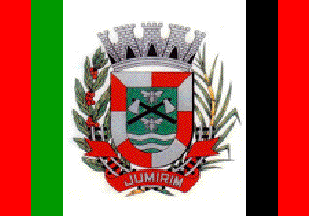
Last modified: 2013-04-27 by ian macdonald
Keywords: sao paulo | jumirim |
Links: FOTW homepage |
search |
disclaimer and copyright |
write us |
mirrors
 image by Ivan Sache, 18 April 2013
image by Ivan Sache, 18 April 2013
Jumirim was founded in 1886 as a railway station built by "Estrada de
Ferro Sorocabana" on the Barreiro estate, owned by Manoel "Manecão"
Novaes. The station was named for the Jurimirim estate, where it
should originally have been built. The original name of Jurimirim,
meaning "a small waterfall" in Tupi-Guarani, was subsequently changed
to Jumirim to prevent confusion with the municipality of Juru-Mirim.
The district of Jumirim, part of the municipality of Tietê, was
inaugurated on 1 January 1945.
The municipality of Jumirim was established by State Law No. 9,330 of
27 December 1995, following a plebiscite organized on 21 May 1995;
this was the first electronic plebiscite organized in the State.
http://www.jumirim.sp.gov.br - Municipal website
The symbols of Jumirim are prescribed in Article 4 of the Municipal
Constitution, adopted in July 1997, as "the flag, the coat of arms and
the anthem, established by Law". This prescription was added by
Amendment No. 4, adopted in 2006. The Article further states that "the
performance of the municipal anthem is mandatory in all civic or
solemn events and sessions".
http://www.camarajumirim.sp.gov.br/menu_uc.aspx?uc=leiorganica -
Municipal Constitution
The flag and the coat of arms were designed by Lauro Ribeiro Escobar.
The flag is prescribed by Municipal Law No. 197 of 12 December 2002. The flag is white with two vertical, red and green, stripes along the hoist and another two vertical, black and red stripes along the fly. The municipal coat of arms is placed in the middle of the flag. The dimensions of the flag are 14 units x 20 units. The width of the vertical stripes is 2 units. The height of the coat of arms is 12 units. The meaning of the colours is the same as on the coat of arms, argent on the coat of arms matching white on the flag.
The coat of arms is prescribed by Municipal Law No. 85 of 10 May 1999, as "An Iberian shield, vert two machetes argent hilted sable per saltire surrounded by two stars in base two fesses wavy all argent a bordure gyronny argent and gules. The shield surmounted by an eight- towered mural crown argent ports sable. The shield supported dexter by a branch of coffee and sinister by a sugarcane the two proper. Beneath the shield a railway argent superimposed with a scroll gules inscribed with the municipality's name in letters argent".
The Iberian shield, used in Portugal at the time of discovery of Brazil, evokes the first colonizers and builders of the nation. Vert is a symbol of hope, courtesy, civility, liberty, joy, friendship and abundance. It alludes to the fertility of the soil in Jumirim and to the firm aspiration of the people to a promising future. The axes evoke labour, especially timber extraction, one of the factors that contributed to the progress of the municipality..The two fesses wavy represent the water resources in the municipality, especially rivers Tietê end Sorocaba, which have a strong historical meaning. Argent is a symbol of felicity, purity, temperance, truth, frankness, integrity and friendship. Sable is a symbol of strength, constancy, prudence, simplicity, knowledge, science, gravity, moderation, silence and secret. The bees are the symbol of activity, labour, industry, parsimony and sweetness. The bordure is a symbol of favour and protection. Gules is a symbol of audacity, valour, fierceness, intrepidity, magnanimity, honour and nobleness, recalling the early colonizers of the region. Vert, black, argent and gules match the colours of the Italian flag - green, white and red - and of the São Paulo State flag - black, white and red, recalling that this Paulista territory was colonized by Italians. The mural crown is a symbol of municipal emancipation; the open ports are a symbol of hospitality. The branch of coffee and the sugarcane highlight the fertility of the generous soil, being two crops contributing to the income of the municipality. The railway highlights the significance of "Estrada de Ferro Sorocabana" for the development of the region, especially through the inauguration of the station of Jumirim in June 1886.
Article 14 of the Law on the flag amends the Law on the coat of arms, replacing in the description the stars by bees. Since the explanation of the arms in the original Law already mentioned bees and not stars, the original arms must have already included bees. Therefore, the amendment most probably corrected a mistake in the text of the Law.
The Law prescribes the municipal colours as red, white, black, green
and yellow, which are the colours of the municipal coat of arms -
argent matching white.
http://www.camarajumirim.sp.gov.br/menu.aspx?id_menu=2 - Website of
the Municipal Council